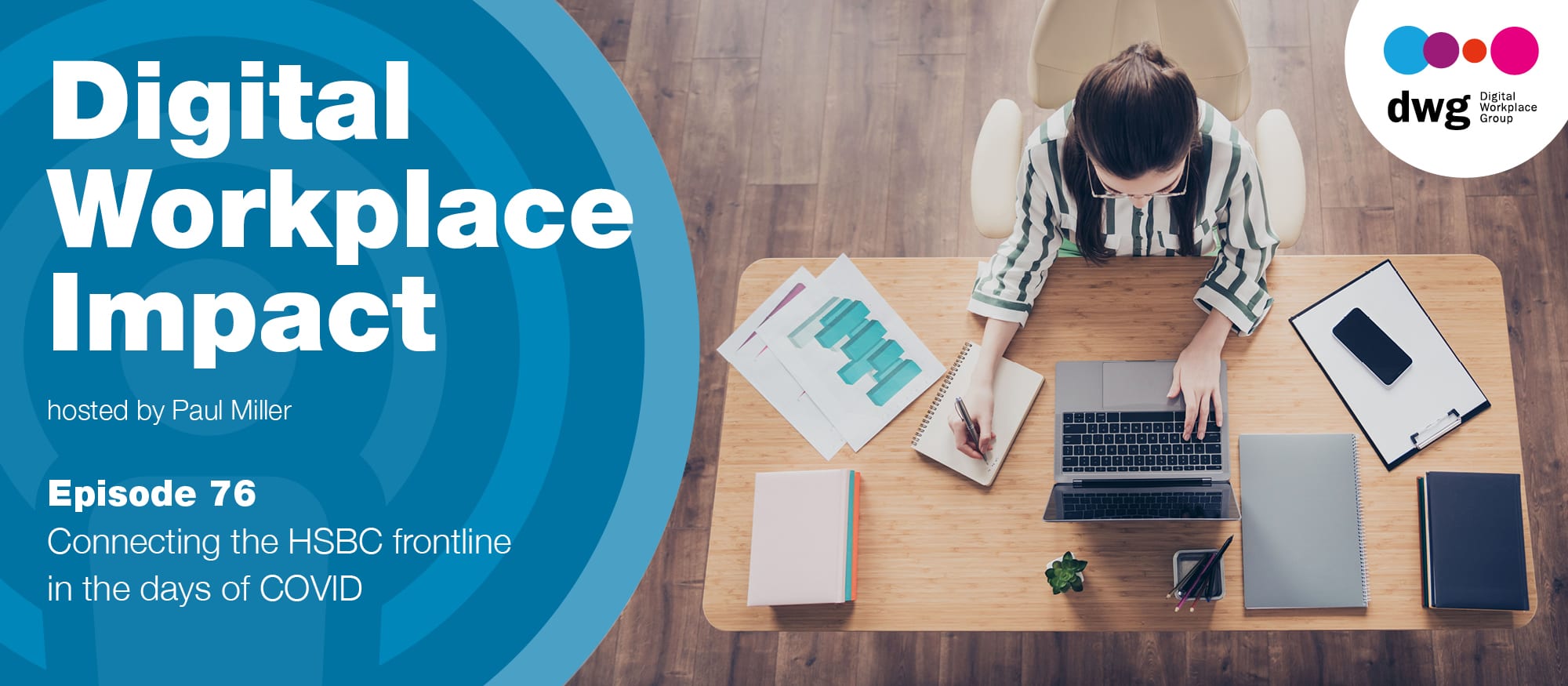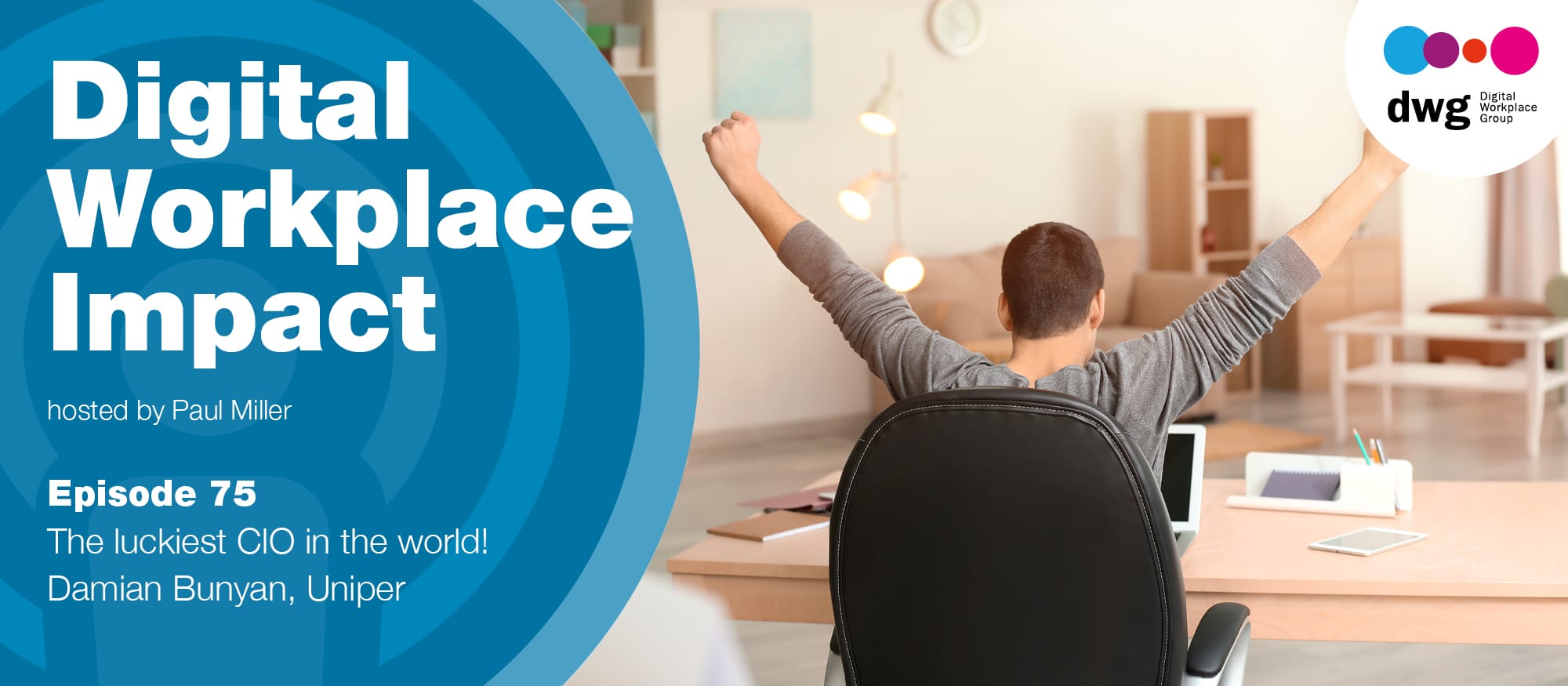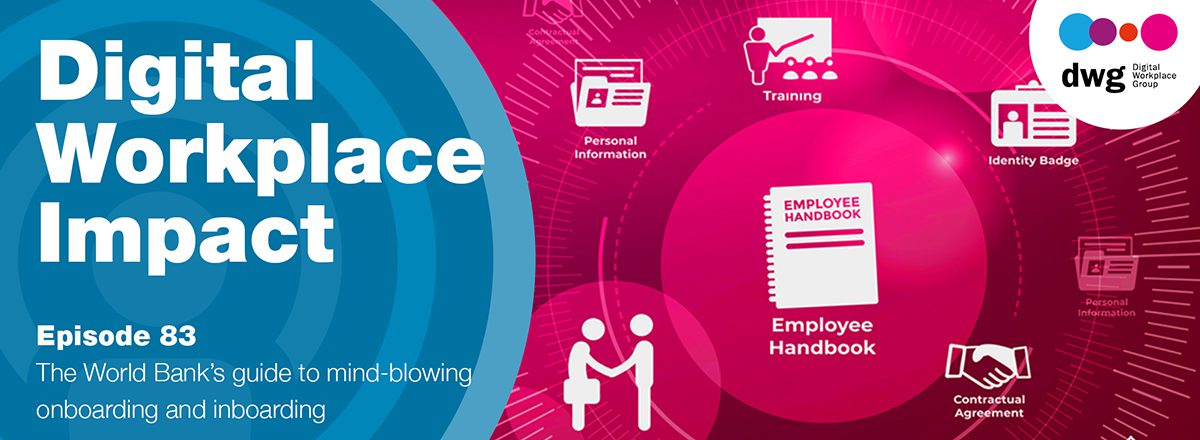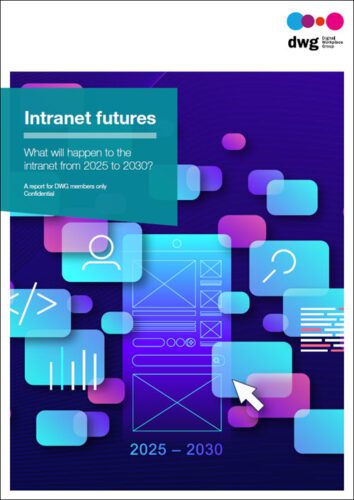How organizations support employee experience: takeaways from the Digital Workplace Impact podcast
I find it hard to believe that we are already up to 85 episodes of Digital Workplace Impact, DWG’s innovative podcast covering all aspects of the digital workplace. 85 episodes! I remember covering the very first episode in a post for DWG members and since then the podcast has gone from strength to strength, featuring industry thought leaders, DWG experts, practitioners and even some left-field guests from outside the industry. It’s covered a very wide range of topics from intranets to the challenges of navigating the pandemic through to being more agile.
I’ve also been lucky enough to be a guest on the show a couple of times, and it’s always a highly enjoyable experience; an engaging conversation on industry topics where you invariably forget you’re being recorded. I think this is one of the successes of the podcast format, because everyone is relaxed and this leads to better conversations.
Recently, there have been some new developments, seeing our first ever podcast sponsor (Workgrid) come onboard, and also the arrival of our new host, Nancy Goebel. While Nancy is developing Digital Workplace Impact, taking it forward to explore and delve deep into all things digital workplace, Paul Miller has moved to focus on a brand new podcast, Nature of Work, presented with Shimrit Janes, co-author of the book of the same name. Having said that, Paul has already returned to Digital Workplace Impact as a guest!
Supporting employee experience
A theme that has been covered several times on the podcast in recent months is employee experience and the ‘digital’ aspects of this. Digital employee experience is a wide-ranging and important area, where many organizations are trying to take more strategic and joined-up approaches to the touchpoints employees have with workplace technology. It’s taken many years for organizations to take this as seriously as they do customer experience – and the pandemic and resulting experiences of remote and hybrid working have ensured it continues to be a priority.
I have recently listened to three episodes of the podcast broadcast this year, which I think interestingly reveal some of the different approaches organizations are taking to improving the digital employee experience. Here are my takeaways from these three episodes of Digital Workplace Impact.
Connecting the HSBC frontline in the days of COVID
In the past, frontline employees have tended to lag behind knowledge workers in terms of the depth and quality of their digital employee experience, as well as their relative access to information, services and systems. While this was already beginning to change, the pandemic has (hopefully) been a catalyst for further reducing and even eliminating this digital divide. There were several reasons for this, including the need to ramp up systems that would provide everyone with access to the digital workplace and trusted communications during lockdowns, but also the pandemic generally proved a reminder of our collective reliance on frontline employees, not just within organizations but across society as a whole.
In a fascinating episode of Digital Workplace Impact, Paul Miller spoke to Kate Mayfield, Head of Delivery, Digital Fraud, HSBC, about the way the bank supported frontline employees from branches and call centres during the pandemic (as well as back office staff), and the amazing efforts employees went to in order to support both customers and each other. Many of the insights from the episode will resonate with others who saw colleagues pull together and deliver incredible achievements very quickly.
A takeaway for me was that to truly deliver a strong employee experience for frontline staff, particularly during a crisis, a range of operational and cultural approaches are needed. Kate talked about the importance of agile approaches that enabled swift decision-making from leadership and management, but also ensured that development teams working on sprints could switch their efforts to where help was needed the most, sometimes changing on a daily basis.
Having the right technology in place was also key; the bank had already started to roll out Zoom in 2019 and was able to fully scale this up in 2020. It was also able to accelerate technologies that had been in partial development or pilot stages, for example rolling out a virtual document-signing solution that potentially saved parts of the bank millions of pounds. This agility extended to operations too, with call centre staff working on more flexible rostering.
‘Softer’ elements are absolutely critical as well; for example, providing call centre staff with resilience training and cybersecurity awareness so that they would be both comfortable and knowledgeable about operating in the digital workplace. The bank also spent millions on wellbeing for staff, including providing access to support services, as well as events such as virtual mindfulness sessions.
Kate mentioned the importance of an existing ‘caring’ culture, which meant that many staff went the extra mile to help customers and colleagues, feeling a sense of duty to support bank customers who might be struggling financially and, as a result, working very long hours. Anecdotes detailing super-human efforts, such as delivering PCs by helicopter to enable staff to work, were commonplace.
This caring culture also extended to leadership, who felt empowered by the ‘levelling up’ of communications facilitated by everyone being online. They found there was more parity in online meetings conducted from home, with participants more confident to speak up than when they had been dialling into a hybrid meeting partially held at the office.
The luckiest CIO in the world!
A good digital employee experience doesn’t just happen overnight; it requires solid foundations and evolution to get there. Usually this means having the right kind of cloud-based IT infrastructure that can support both remote and flexible working, arguably the backbone of any good digital employee experience.
In the intriguingly titled episode ‘The luckiest CIO in the world!’, Paul Miller talked to Damian Bunyan, the CIO of Juniper, a global energy company that is headquartered in Germany and has 12,000 employees. Formed from a reorganization of utility company E.ON, Bunyan detailed how Juniper started to move to a Microsoft-based cloud infrastructure in 2016 in what was quite a pioneering move within the risk-averse energy industry. Being an early cloud adopter has meant the company is now ahead of most of its competitors and has become the first energy company to move various processes, such as energy trading, fully into the cloud.
For me this was a salient reminder that the cloud is a major enabler of digital employee experience. Damian touched upon aspects of this, including a reduction in outages and disruption (“things in the cloud just work”) and how cloud-based tools like Microsoft Teams have greatly improved communication and live events, enabling more employees to communicate more directly with senior management.
But it is the power of the cloud to facilitate remote working that has arguably had the most impact on employee experience. During COVID-19, Juniper was able to move all 12,000 employees to working remotely more or less overnight; this includes the ability for people to run power stations “from their sofas” as well as to trade energy from their kitchen tables.
And why does Damian consider himself to be the luckiest CIO in the world? Because he believes they were ‘lucky’ in having to move towards the cloud and they’re now enjoying multiple benefits including relatively smooth business continuity during the pandemic; this strong position is recognized (and often mentioned) by E.ON’s CEO.
The World Bank’s guide to mind-blowing onboarding and inboarding
Employee onboarding is often a priority area for HR and digital workplace teams focusing on improving the digital employee experience. This is partly because it’s an area where digital channels can make a real difference in helping new hires to work through the never-ending tasks and learning they need to complete when they first join a company; online channels can also help new employees to feel more welcome. The move to remote working due to COVID-19 has placed the focus on the digital side of employee onboarding, where many organizations are trying to reconfigure face-to-face programmes so they work in a virtual setting.
In this illuminating episode, Ghislaine Baghdadi, who runs the World Bank’s global onboarding programme, walks us through some of the main features of the initiative. This is a programme with high aspirations; Baghdadi explains that her aim is to make the experience of joining the bank “mind-blowing”.
This episode is packed full of insights from a mature, scaled programme which deals with more than 1,000 new hires a year. It shows that it is possible to take a fully formed face-to-face nine-step onboarding programme and recreate it virtually, through a series of structured learning events with different subject matter experts covering a range of aspects of life at the bank. The team also hold a series of more practical sessions, called ‘Nuts and Bolts’, that have been designed based on feedback from new hires.
A takeaway for me was that there are two essential ingredients which are not always part of the onboarding programme. Networking is very much part of the face-to-face experience and the World Bank has managed to reproduce some of this virtually with small networking groups of around five or six new hires, all of whom may attend a Zoom call. The team also have a tried-and-tested approach to measurement and reporting. This picks up new-hire feedback and later checks in with them a few months down the line to assess the impact. The fact that the onboarding experience is rated 6.4 out of 7 by new hires suggests the team are getting things right when it comes to employee experience in this area.
This podcast episode also features some fresh thinking on onboarding, focusing on more localized experiences, which Baghdadi has labelled “inboarding”. Definitely worth a listen!
Talk to us about…
… becoming a DWG member
Categorised in: Digital employee experience




